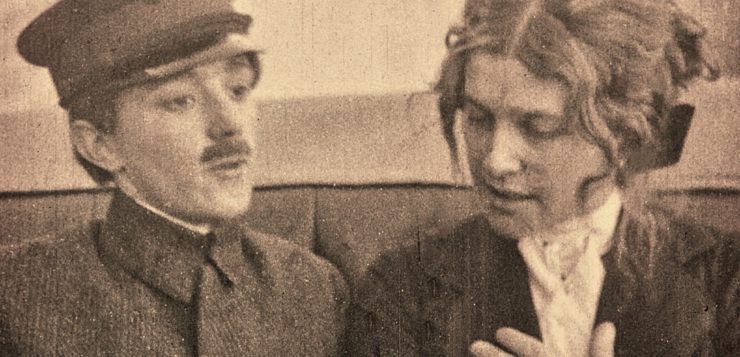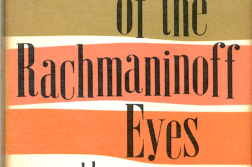MARIO RONCORONI’S FILIBUS was Corona Films’ top-billing serial for 1915. Shot on a tight budget in northern Italy, it’s a silent caper movie in which the title character, a criminal mastermind, employs cunning and state-of-the-art technology to steal a couple of priceless Egyptian diamonds. Along the way, the mysterious Filibus takes some time to seduce Leonora, the beautiful sister of police detective Kutt-Hendy, the man who’s trying to thwart the crime.
Here was a silent film featuring thrilling locations, an airship as the secret base of the title criminal, and a number of James Bond-style gadgets, all in the service of the first gender-fluid character in movie history. Filibus is a cross-dressing international person of mystery who impersonates both the glamorous Baroness of Troixmonde and the foppish Count de la Brive in the course of the movie. She is revealed in a final twist to be a woman, and cinema’s first openly lesbian heroine was born.
In the early 20th century, criminal masterminds were all the rage. In 1898, H. W. Hornung’s Raffles, “the Amateur Cracksman,” opened the way in Britain, but it was the French who embraced the concept with anarchic gusto during the Belle Époque. The adventures of Maurice Leblanc’s Arsene Lupin (1905) and Allain & Sauvestre’s Fantomas (1911) were controversial instant bestsellers, soon adapted for the screen. In 1915, silent movie siren Musidora portrayed Irma Vep, the ruthless leader of the Paris criminal cabal known as “Les Vampires.” Criminals-as-heroes were a worldwide sensation, much to the censors’ chagrin, and the public kept asking for more.

(Cristina Ruspoli) in Filibus. Milestone Films and Eye Filmmuseum.
When the film hit the theaters—both as a full-length feature film and a five-part serial—Italy was a place of contradictions, where a woman could get a pilot’s license but still needed her father’s or her husband’s signature to subscribe to a newspaper. Perpetually cast in their role as self-sacrificing mothers, Italian women won the right to vote only in 1945. But the world was changing in the 1910s, and there was a palpable restlessness in the air.
Filibus was a response to this restlessness. Like her contemporary Irma Vep, Filibus was a “new woman criminal,” a law-breaking version of the Belle Époque’s “New Woman”: independent and liberated, wearing pants, riding a bicycle, smoking (but only at home), and demanding equal rights. Connecting with the zeitgeist, Bertinetti also drew inspiration from Valentine de Saint-Point’s 1912 “Manifesto of Futurist Woman”—a response to the Futurist Manifesto’s blatant misogyny—and created a truly subversive character.
The name “Filibus” is a portmanteau of the Greek fìlos, meaning “love,” and the Latin omnibus, for “all”—referring not to the character’s good heart but to her willingness to cross gender boundaries. But Filibus’ gender-bending is not limited to her pursuit of the ingénue Leonora. She takes control of a number of domains that have heretofore been the exclusive province of men. She’s an adventuress and a criminal, but also a femme fatale and a mastermind—sexually seductive and able to stay two steps ahead of the police. Also, she has full command of technology and science, areas from which women have traditionally been excluded.
Filibus moves freely between gender roles, as she does between the criminal underground and high society, equally at ease at a fancy ball and at the helm of a futuristic flying machine. The Futurist dream of an engine-like future society comes to fruition in the character of Filibus, together with Valentine de Saint-Point’s ideal of an active, self-actualizing new woman, a “warrior-woman” sharing both masculine and feminine traits who can shrug off men if she pleases and embrace her love of adventure for adventure’s sake. By subverting the rules to her advantage, she thrills the men and seduces the women—fully fifteen years before Marlene Dietrich’s cross-dressing role in Morocco.
It’s hard to imagine the effect of a film like Filibus on Italian and European public opinion of the time. The reviews were generally positive, though some critics noted the cheap special effects. The inventive plot was appreciated, the actors’ skills acknowledged, and Filibus was poised to become a big commercial success.
At the end of the film, the title character escapes with the jewels, and the detective pursuing her is framed as the actual thief. His sister rejoins her straight (and rather dull) fiancé, but a lingering suspicion remains that she actually had more fun with her cross-dressing lesbian paramour. As Filibus plans a new crime, the scene is set for a sequel, the start of a franchise. But that never happened. The Great War came to Italy a few weeks after the movie’s premiere, and by 1918 Corona Films has gone bankrupt.
Filibus disappeared and became the stuff of legend, a “lost movie.” Details about the plot and cast were patched together by film historians through screening notes, reviews, and the few surviving posters and stills. Then, in 1997, a copy of the film resurfaced in the Dutch Film Museum as part of the Desmet Collection. Cinema owner Jean Desmet had acquired a copy soon after the film’s premiere, and it was so successful in his theaters that Desmet showed it regularly for almost ten years.
The recovered film was screened at the Festival del Cinema Ritrovato, organized by the Cineteca di Bologna in 1997. Later, at the 2013 Women’s Film Festival in Dortmund, Filibus was hailed as “probably the first lesbian heroine in the history of cinema.” In 2017, the film screened at the San Francisco Silent Film Festival. Today, a restored version is available on a DVD published by Milestone Films, and low-quality copies can be viewed on YouTube.
Davide Mana, formerly an environmental scientist, works as a writer and translator.






